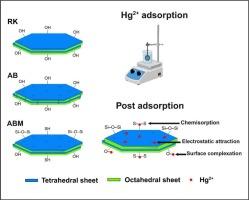硫醇功能化高岭土颗粒:开发和优化从水溶液中去除汞离子
IF 5.8
2区 地球科学
Q2 CHEMISTRY, PHYSICAL
引用次数: 0
摘要
水介质中的汞污染由于其高毒性和潜在的生物蓄积性,造成了严重的环境和健康风险。在这项研究中,开发了一种新型的硫醇接枝高岭土颗粒吸附剂,用于高效的Hg2+修复。球团的生产包括酸碱处理、3-巯基丙基三甲氧基硅烷接枝和聚乙烯醇作为粘合剂的挤压。此外,还开发了一种新的方法来评估生产的颗粒上的生物膜形成。表征结果证实了巯基的成功接枝,为Hg2+离子提供了高亲和力的结合位点。确定了最佳操作条件:2 mm球团,1.5 wt% PVA, 5 g/L投加量,初始溶液pH为5,在313 K下达到74.2%的去除率和12.5 mg/g的吸附量。动力学研究表明,Hg2+吸收服从拟二阶模型(R2 = 0.986),等温线研究表明,Freundlich模型(在293、303和313 K下,R2分别= 0.987、0.993和0.997)是最佳模型。抗菌实验表明,未经处理和酸碱处理的高岭土颗粒抑制大肠杆菌(BL21)、铜绿假单胞菌、表皮葡萄球菌和金黄色葡萄球菌的生物膜形成,而硫醇接枝的颗粒则促进了生物膜的形成,强调了平衡吸附增强与潜在微生物定植的必要性。这些发现证实了高岭土颗粒吸附剂修复Hg2+的潜力,为扩大到工业应用提供了可行的框架。本文章由计算机程序翻译,如有差异,请以英文原文为准。

Thiol functionalized kaolin pellets: Development and optimization for mercury ion removal from aqueous solutions
Mercury contamination in aqueous media poses a severe environmental and health risk due to its high toxicity and bioaccumulation potential. In this study, a novel thiol-grafted kaolin pellet adsorbent was developed for efficient Hg2+ remediation. The pellet production involved a combination of acid-base treatment, 3-mercaptopropyltrimethoxysilane grafting, and extrusion with polyvinyl alcohol serving as a binder. Additionally, a novel approach was developed to assess biofilm formation on the produced pellets. Characterization results confirmed the successful grafting of thiol groups, providing high-affinity binding sites for Hg2+ ions. Optimal operating conditions were identified using 2-mm pellets, 1.5 wt% PVA, 5 g/L dosage, and an initial solution pH of 5, achieving 74.2 % removal and adsorption capacities of up to 12.5 mg/g at 313 K. Kinetic studies revealed that Hg2+ uptake followed a pseudo-second-order model (R2 = 0.986), while isotherm studies indicated the Freundlich model (R2 = 0.987, 0.993, and 0.997 for 293, 303, and 313 K, respectively) as the best model. Antibacterial assays demonstrated that raw and acid-base-treated kaolin pellets inhibited biofilm formation for E. coli (BL21), P. aeruginosa, S. epidermidis, and S. aureus, whereas thiol-grafted pellets promoted biofilm development, highlighting the need to balance adsorptive enhancement with potential microbial colonization. These findings confirm the potential of kaolin-based pellet adsorbents for Hg2+ remediation, offering a viable framework for scaling up into industrial applications.
求助全文
通过发布文献求助,成功后即可免费获取论文全文。
去求助
来源期刊

Applied Clay Science
地学-矿物学
CiteScore
10.30
自引率
10.70%
发文量
289
审稿时长
39 days
期刊介绍:
Applied Clay Science aims to be an international journal attracting high quality scientific papers on clays and clay minerals, including research papers, reviews, and technical notes. The journal covers typical subjects of Fundamental and Applied Clay Science such as:
• Synthesis and purification
• Structural, crystallographic and mineralogical properties of clays and clay minerals
• Thermal properties of clays and clay minerals
• Physico-chemical properties including i) surface and interface properties; ii) thermodynamic properties; iii) mechanical properties
• Interaction with water, with polar and apolar molecules
• Colloidal properties and rheology
• Adsorption, Intercalation, Ionic exchange
• Genesis and deposits of clay minerals
• Geology and geochemistry of clays
• Modification of clays and clay minerals properties by thermal and physical treatments
• Modification by chemical treatments with organic and inorganic molecules(organoclays, pillared clays)
• Modification by biological microorganisms. etc...
 求助内容:
求助内容: 应助结果提醒方式:
应助结果提醒方式:


